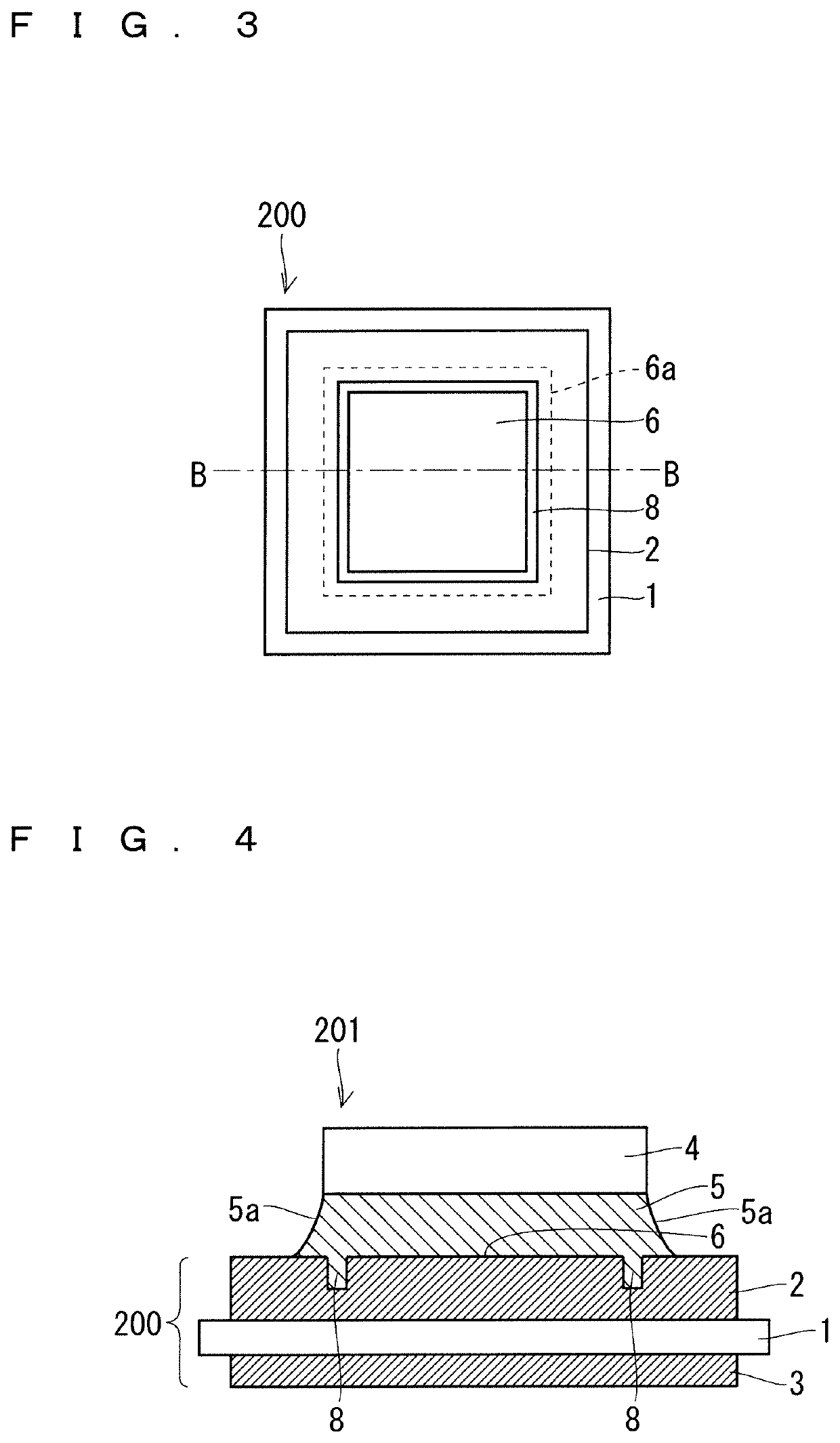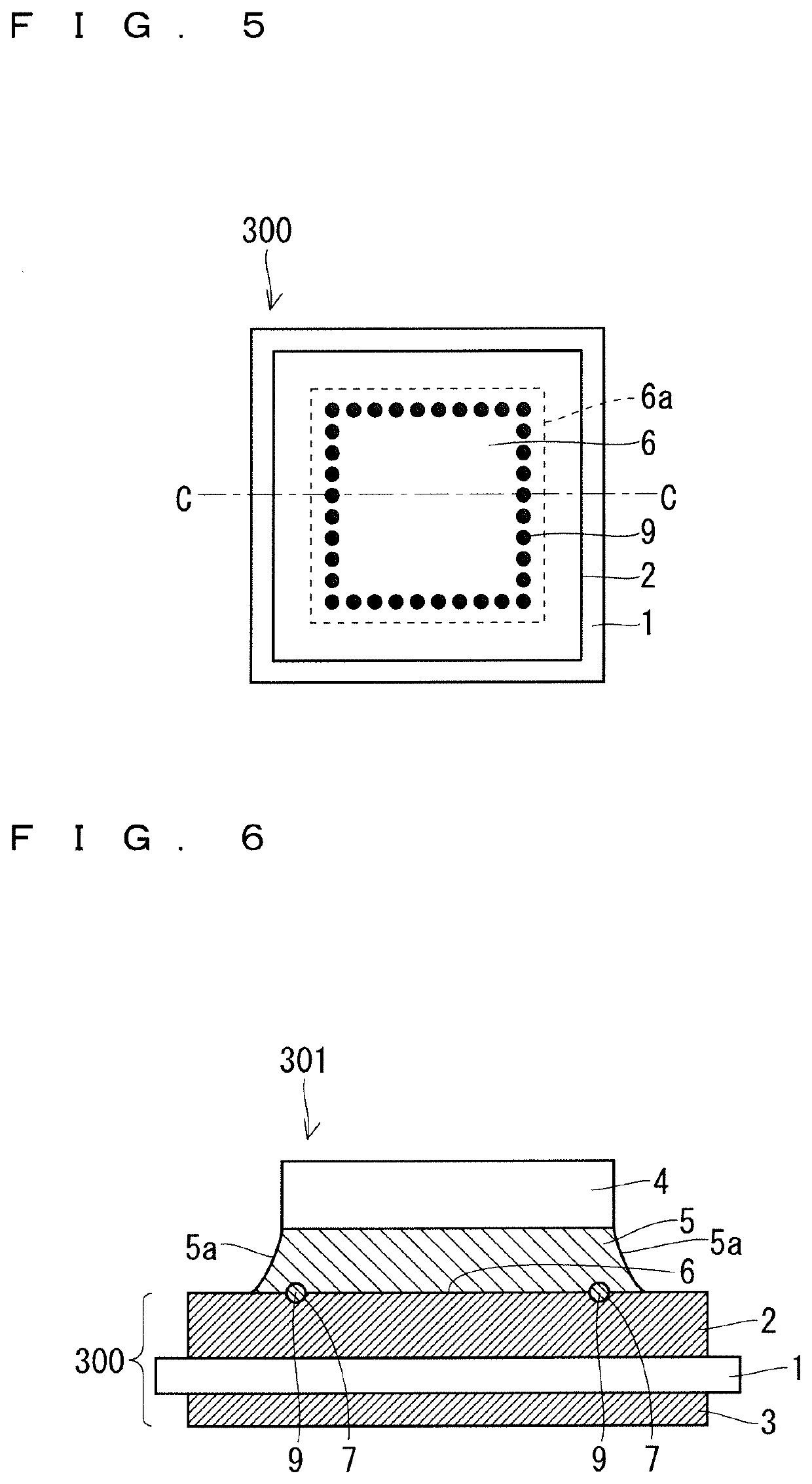Semiconductor element bonding substrate, semiconductor device, and power conversion device
a technology of semiconductor devices and semiconductor elements, applied in semiconductor devices, semiconductor/solid-state device details, electrical apparatus, etc., can solve the problems of reduced characteristics and easy shrinkage of the shell cavity, and achieve the effects of reducing the shrinkage of the fillet part, improving heat radiation properties, and increasing heat capacity
- Summary
- Abstract
- Description
- Claims
- Application Information
AI Technical Summary
Benefits of technology
Problems solved by technology
Method used
Image
Examples
embodiment 1
[0028]FIG. 1 is a plan view of a semiconductor element bonding substrate 100 according to a present embodiment 1. FIG. 2 is a cross-sectional view of a semiconductor device 101 according to the present embodiment 1. In the semiconductor device 101 illustrated in FIG. 2, a semiconductor element 4 is bonded to a bonding region 6a in the semiconductor element bonding substrate 100 by a solder 5. A cross section of the semiconductor device 101 illustrated in FIG. 2 corresponds to a cross section along a line segment A-A in FIG. 1.
[0029]The semiconductor element bonding substrate 100 includes an insulating plate 1 and a metal pattern 2. The metal pattern 2 is bonded to a main surface of the insulating plate 1. A main surface 6 of the metal pattern 2 on an opposite side of the insulating plate 1 includes the bonding region 6a to which the semiconductor element 4 is bonded by the solder 5. A plurality of concave parts 7 are formed in the bonding region 6a in the main surface 6 of the metal...
embodiment 2
[0037]FIG. 3 is a plan view of a semiconductor element bonding substrate 200 according to a present embodiment 2. FIG. 4 is a cross-sectional view of a semiconductor device 201 according to the present embodiment 2. In the semiconductor device 201 illustrated in FIG. 4, a semiconductor element 4 is bonded to a bonding region 6a in the semiconductor element bonding substrate 200 by a solder 5. A cross section of the semiconductor device 201 illustrated in FIG. 4 corresponds to a cross section along a line segment B-B in FIG. 3.
[0038]The semiconductor element bonding substrate 200 includes an insulating plate 1 and a metal pattern 2. The metal pattern 2 is bonded to a main surface of the insulating plate 1. A main surface 6 of the metal pattern 2 on an opposite side of the insulating plate 1 includes the bonding region 6a to which the semiconductor element 4 is bonded by the solder 5. A continuous groove 8 is formed in the bonding region 6a in the main surface of the metal pattern 2. ...
embodiment 3
[0042]FIG. 5 is a plan view of a semiconductor element bonding substrate 300 according to a present embodiment 3. FIG. 6 is a cross-sectional view of a semiconductor device 301 according to the present embodiment 3. In the semiconductor device 301 illustrated in FIG. 6, a semiconductor element 4 is bonded to a bonding region 6a in the semiconductor element bonding substrate 300 by a solder 5. A cross section of the semiconductor device 301 illustrated in FIG. 6 corresponds to a cross section along a line segment C-C in FIG. 5.
[0043]The semiconductor element bonding substrate 300 further includes a metal member 9 located in each of the plurality of concave parts 7 when compared with the semiconductor element bonding substrate 100 (FIG. 1) in the embodiment 1. The metal member 9 is formed of a material having a larger heat conductivity than the solder 5. The metal member 9 has a spherical shape. The metal member 9 is made of Cu, Ni, Au, Ag, Cu plated with Ni, or Al plated with Ni, for...
PUM
| Property | Measurement | Unit |
|---|---|---|
| semiconductor | aaaaa | aaaaa |
| heat conductivity | aaaaa | aaaaa |
| electrical power | aaaaa | aaaaa |
Abstract
Description
Claims
Application Information
 Login to View More
Login to View More - R&D
- Intellectual Property
- Life Sciences
- Materials
- Tech Scout
- Unparalleled Data Quality
- Higher Quality Content
- 60% Fewer Hallucinations
Browse by: Latest US Patents, China's latest patents, Technical Efficacy Thesaurus, Application Domain, Technology Topic, Popular Technical Reports.
© 2025 PatSnap. All rights reserved.Legal|Privacy policy|Modern Slavery Act Transparency Statement|Sitemap|About US| Contact US: help@patsnap.com



